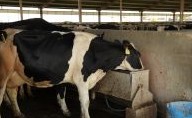The Upside of Inflammation: Kansas State University Study Finds Surprising Benefits
Published: October 29, 2013
Source : K-State- Research and Extension
Research on Dairy Cows May Have Implications for Other Species
 MANHATTAN, Kan. – Inflammation. The word typically has a negative connotation. Arthritis … infection … numerous maladies come to mind.
MANHATTAN, Kan. – Inflammation. The word typically has a negative connotation. Arthritis … infection … numerous maladies come to mind.But a Kansas State University researcher found that inflammation that occurs naturally in dairy cows the first few days after giving birth may play a surprisingly beneficial role in the complex process of going from late pregnancy to lactation.
“We know that during the first several days after giving birth and going into the lactating phase, dairy cows naturally experience some degree of inflammation,” said Barry Bradford, associate professor in K-State’s Department of Animal Sciences and Industry. “We also know that many disorders, including metabolic diseases such as ketosis and fatty liver, occur during this time of transition.”
He, along with a team of researchers from K-State, Iowa State University and Michigan State University, wondered if inflammation actually causes the metabolic problems.
Thinking that reducing inflammation during this period might be beneficial for the cow’s transition from gestation to lactation, plus limit metabolic disease, Bradford and the team conducted a study. The objective was to determine if using an anti-inflammatory drug (sodium salicylate or SS) for the first seven days of lactation would prevent liver fat accumulation, improve the supply of glucose for lactation, and limit metabolic disease in dairy cows entering lactation. SS was delivered to the animals in a controlled way to their drinking water.
The team did not get the result they expected.
“Our findings suggest that mild inflammation may be a necessary part of a cow’s adaptation to lactation,” Bradford said.
Among the significant findings, the research showed that rather than preventing fatty liver by blocking the inflammation, liver fat content was actually increased in the first week of lactation. Similarly, anti-inflammatory treatment led to a dramatic drop in plasma glucose concentration in mature cows. Both of these responses are often associated with metabolic disease in early lactation cows.
“The study improved our understanding of the re-prioritization process by suggesting that inflammatory pathways promote a temporary state of insulin resistance in dairy cows, resulting in conservation of glucose for use by the mammary gland,” Bradford said.
The results of the study, which was funded by the U.S. Department of Agriculture’s National Institute of Food and Agriculture, indicate that inflammation-induced insulin resistance is in some cases an adaptive, rather than pathological, phenomenon. It may help clarify why the links between inflammation and metabolism have survived the evolution process, he said.
And it’s not just cattle that experience the shift in demands on the body: “Many species experience these dramatic shifts,” Bradford said. “The role of inflammation in this process has not been studied very much. We are missing some information about why our bodies are wired the way they are – even after evolutionary refinement of the immune system, there seems to be a role for inflammation in metabolic function.”
The research team’s findings have been published by the American Journal of Physiology. (click here)
“Our findings suggest that we want some degree of inflammation at this time because it helps the animal shift gears,” Bradford said. “Rather than thinking of mild inflammation as a disease-inducing factor, we think there may be times during life where some inflammation is advantageous or necessary.”
The research team plans to delve into the topic further and is seeking funding to find evidence of the phenomenon in other species.
Source
K-State- Research and ExtensionRelated topics
Join to be able to comment.
Once you join Engormix, you will be able to participate in all content and forums.
* Required information
Would you like to discuss another topic? Create a new post to engage with experts in the community.
Create a post3 de diciembre de 2013
So how can we optimize the level of inflammation that is suitable for this process? It seems that nature will regulate it. We need to elucidate the molecular mechanism to make it clear.
Engormix
30 de octubre de 2013
HA DUONG THI THANH,
You can find a link at the end of the story that says CLICK HERE and leads you to the technical article. After reading it, you will be able to understand more about this interesting study conducted by KState Researchers.
Thanks,
Minh Dang Trading and Servicing Company
29 de octubre de 2013
WE do not understand much what you are talking about.
Please send more information easier to understand.
Thank you very much
29 de octubre de 2013
Sometime it is advised for PGF2alpha injection postpartum with benefit in uterine involution. What is the mechanism for early uterine involution?
Universidad de Guadalajara
29 de octubre de 2013
Inflammation of what? The mamary gland, the uteros, the joins, the hooves,???
Just to be sure what are we talking about.
Thanks Jose Zorrilla R., Universidad de Guadalajara, Jalisco, México.







.jpg&w=3840&q=75)